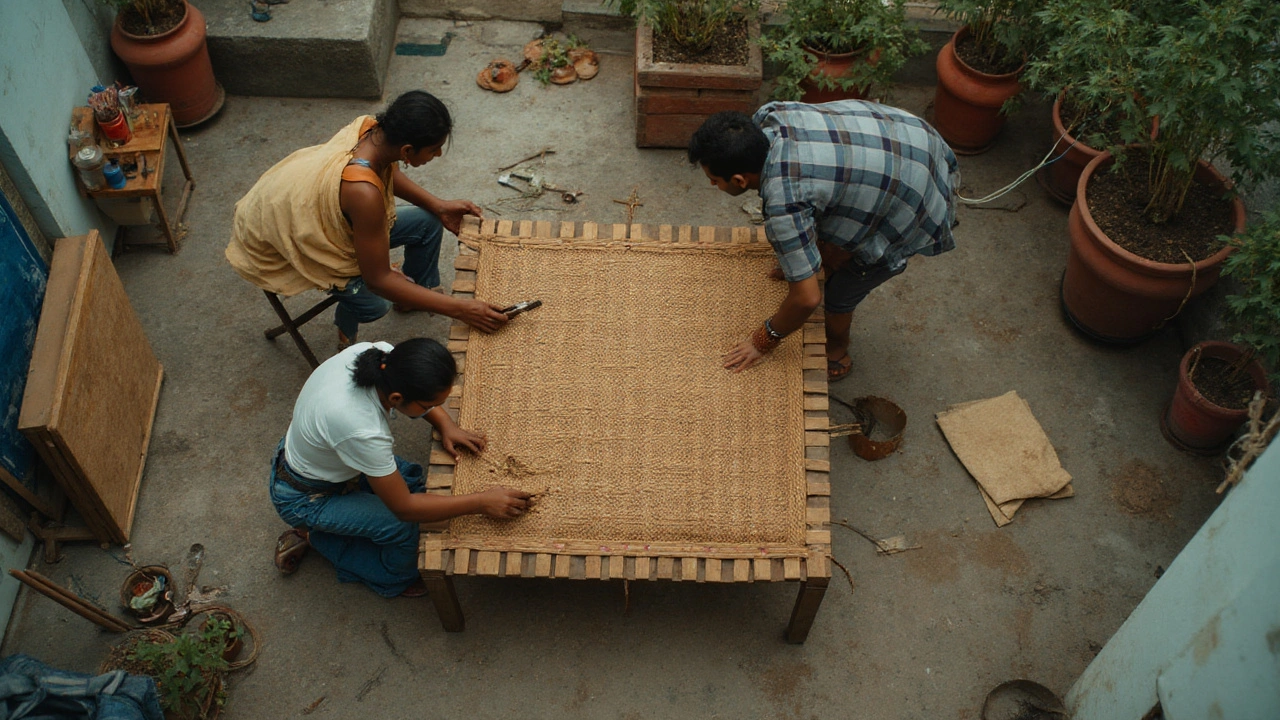Your couch isn’t broken, it’s just tired. Most discomfort comes from soft, collapsed foam, saggy support under the seats, or covers that have stretched and stopped holding shape. You can fix that without buying a new sofa. Expect small, cheap wins in under an hour, or a weekend project that makes the seat feel close to new. I live in Sydney where summer humidity and open windows are the norm, so the tips below lean breathable, durable, and budget-friendly.
If you only remember one thing: the comfort problem is usually 50% inside the cushion (foam/fill) and 50% under it (springs/webbing/frames). Deal with both and your couch cushions will feel right again.
TL;DR: Fast ways to make old couch cushions more comfortable
- Quick refresh (15-30 min): vacuum, steam, sun the cushions for an hour, then karate-chop and re-fluff. Add a thin polyester wrap to plump flat edges.
- Cheap upgrade (under $50): add a 200-300 gsm Dacron/polyester wrap around each cushion core to restore crown and remove hard edges.
- Best value (from $80-$180 per cushion in Australia): replace the foam core with high-resilience (HR) 35-45 kg/m³ seat foam; wrap it in Dacron and reuse your cover.
- Fix the base (from $25): add a plywood panel or webbing under the seat to stop the “hammock” sag. This often matters more than new foam.
- When to stop: if the frame creaks, arms wobble, or sinuous springs have snapped across more than one seat, replacing the sofa may be smarter than throwing parts at it.
Find the real problem first (then pick the right fix)
Before you buy anything, run these quick checks. You’re looking for where the softness comes from: inside the cushion, under the cushion, or both.
- Press test: Press your palm into the cushion center. If it flattens with little bounce, the foam is fatigued. If the cushion feels okay in your hands but the seat still sags when you sit, the base (webbing/springs) is the culprit.
- Edge roll check: Sit near the front edge. If you roll forward, the front foam has collapsed or the deck beneath has stretched. A Dacron wrap plus under-seat support usually fixes this.
- Cover fit: Does the cover look baggy with wrinkles? A loose cover can make a decent foam feel sloppy. Re-stuffing and adding wrap can tighten it up.
- Sound and wobble: Creaks or movement from the frame when you shift your weight means the problem is structural. Tighten bolts and corner blocks first.
- Hot seat? If you feel sweaty or sticky, your fabric and foam combo is trapping heat. Choose breathable wraps (poly/Dacron) and avoid thick memory foam slabs as the main core.
Now match your problem to the fix:
- Flat but firm enough: Add a polyester/Dacron wrap. Minimal cost, fast lift in comfort and looks.
- Soft and bottoming out: Replace the foam core with HR 35-45 kg/m³. This is the biggest comfort upgrade per dollar.
- Sagging even with decent cushions: Reinforce the base with plywood or add webbing/seat savers.
- Baggy covers: Restuff with new fill or add 10-15% larger foam thickness than the cover dimensions to get a snug fit.
Two quick examples:
- Feather/down cushions, sofa still comfy but messy: Pull the insert, add a thin HR foam slab (2-3 cm) inside the down envelope as a center “stabilizer,” then fluff. You keep the plush feel without the sinkhole.
- Budget foam, three-seater from 2018: Replace each seat with HR 38-40 kg/m³ foam at the original thickness, plus 200-300 gsm wrap. Add a 12 mm plywood deck under the seats. The sofa stops swallowing you.

DIY upgrades that actually work (from cheapest to best)
These are ordered by bang-for-buck. I’ve included Sydney/Australia notes on where materials are common and what they cost in 2025.
0) Tools and supplies you’ll likely need
- Fabric scissors, measuring tape, marker
- Upholstery needle and heavy thread or sewing machine (size 16/100 needle)
- Staple gun with 8-10 mm staples (for webbing/decking) and a small hammer
- Spray bottle with water, garment steamer, vacuum with upholstery tool
- Polyester/Dacron batting (200-300 gsm), upholstery foam (HR 35-45 kg/m³)
- Upholstery webbing (synthetic or jute) or a “seat saver” panel
- 12 mm plywood sheet (structural grade), sandpaper, fabric or felt to cover edges
1) Quick refresh (no buying yet)
- Vacuum deeply: Use the upholstery tool to pull dust out of seams. Dust acts like grit and kills foam faster.
- Steam to revive loft: A garment steamer on the outside of the cover loosens fibers. Light passes, don’t soak.
- Sun bath: One hour in morning sun on each side helps kill odours and freshens the fill. Avoid harsh midday sun to prevent fading.
- Fluff and chop: Hold each cushion by the sides, punch the edges to move fill back to corners, then karate-chop the top to restore crown.
Expected gain: a little more spring, cleaner smell, flatter wrinkles. Cost: $0. Time: 30-60 minutes.
2) Add Dacron/poly wrap (15-30 minutes per cushion)
- Measure the foam core length, width, and thickness.
- Cut polyester batting to wrap around the sides with a 5-8 cm overlap.
- Spray-mist the batting with water (helps it settle), then wrap it tightly around the foam.
- Secure the overlap with light spray adhesive (water-based upholstery adhesive) or a few hand stitches. Avoid solvent-heavy glue indoors.
- Slide the wrapped core back into the cover. Work corners in slowly to avoid bunching.
Why it works: the wrap creates a rounded “crown,” hides edges, and firms up the seat edges where you feel pressure the most. In Sydney, you can grab batting from craft stores or big-box hardware stores.
3) Re-stuff or split-layer a feather/down cushion
- Open the zip and pull out the insert. If feathers poof out, work outside with a sheet on the ground.
- Add a thin HR foam panel (2-3 cm) in the middle of the envelope, or insert a new inner casing with channels if the down has migrated.
- Top up the chambers with clean polyester fiberfill or a 10-20% feather/down blend to keep softness without instant collapse.
- Close, fluff, and let it sit for a few hours so air returns to the fill.
Result: you keep that sink-in luxury but gain a stable platform under your sit bones.
4) Replace the foam core (the biggest comfort upgrade)
This is the move when your cushion is pancake-soft or bottoms out. Focus on density and firmness that suits sitting, not bedding.
- Density (Australia): aim for HR foam at 35-45 kg/m³ for seats. Dunlop Foams AU and similar suppliers list these as “seating” grades in their 2024-2025 spec sheets.
- Firmness (IFD/ILD): for most adults, a medium-firm seat in the 140-200 N (approx. ILD 35-45 lb) range feels supportive. Heavier users or deep-seat sofas can go firmer.
- Thickness: match the original cushion thickness. If your cover is loose, choose foam up to 10% thicker than the empty cover’s height for a snug fit.
- Layering: use a firm base foam with a 1-2 cm softer topper, then wrap in 200-300 gsm Dacron. Avoid full-thickness memory foam as a core-it runs hot and hammocks.
- Safety: pick foams certified low-emission and low-VOC. In practice, look for CertiPUR-US or GECA-certified suppliers here in Australia.
How to swap the core
- Unzip the cover and remove the old core (keep it for tracing).
- Measure seam-to-seam inside the cover. Subtract 1-2 cm to allow for the Dacron wrap’s squeeze, or go true-to-size and rely on the wrap for compression.
- Order cut-to-size foam. Sydney buyers often use foam shops or hardware chains; bring your template for accuracy.
- Wrap the new foam in Dacron as above. Corners should be softly rounded; sharp corners telegraph through fabric.
- Stuff it in: fold the foam like a taco, insert the fold first, then unfurl inside the cover.
Tip: If the zip is struggling, slip a garbage bag over the foam to reduce friction, insert, then pull the bag out.
5) Reinforce the base: plywood, webbing, or seat savers
If you can feel the frame rails when you sit, fix the support under the cushions. This gives an immediate, obvious lift.
- Plywood panel: Cut 12 mm structural plywood to fit the seating area. Sand edges round and cover with felt or fabric so it doesn’t wear the deck cloth. Set it on the rails, not the fabric. Drill a few 20-25 mm holes for airflow to stop mustiness.
- Upholstery webbing: If you can remove the dust cover under the sofa, re-web the seat with synthetic or jute webbing, pulled tight and woven in a grid. Staple ends with 3-5 staples per end.
- Seat saver panels: A quick, tool-free panel that spans the frame under the cushions. Not as perfect as re-webbing but works in rentals or tight budgets.
Note: If you have broken sinuous (zig-zag) springs, you’ll need spring clips and pliers to replace them. If more than one spring is broken across a three-seater, weigh up professional help.
6) Tighten the cover fit
- Add or replace the inner lining (cambric) to reduce friction and keep fill from migrating.
- If the cover has stretched, sew in a new zipper or move the zip stop to gain a tighter closure.
- Add simple internal ties (cotton tape) at the back corners to anchor the insert so it doesn’t walk forward.
7) Breathability and heat
- Choose cotton-blend or performance upholstery with a tight weave and a high rub count for durability. Breathable fabric + HR foam runs cooler than vinyl-like synthetics.
- Skip thick memory foam toppers in humid homes. A thin latex or HR topper with Dacron wrap balances comfort and airflow better here in Sydney summers.
8) Clean and deodorise without wrecking the foam
- Check care tag. If the cover is removable and washable, cold wash and air dry flat to avoid shrink.
- For non-removable covers, use a fabric-safe upholstery cleaner. Mist lightly; don’t soak the foam.
- Sprinkle baking soda on dry fabric, wait 30-60 minutes, vacuum it off to reduce odours.
- Dry thoroughly in moving air. Trapped moisture flattens foam and can smell musty.
Reference points: upholstery foam makers and certification programs advise low-VOC materials and thorough drying; foam that stays damp degrades faster.
Cheat sheets, cost guide, and what to do next
Here’s a straight, Sydney-priced snapshot for 2025. Costs vary by size, fabric, and where you shop, but these ballparks help plan.
| Fix/Upgrade | Typical Cost (AUD) | Time | Comfort Gain | Lifespan Boost | Notes |
|---|---|---|---|---|---|
| Vacuum/steam/sun + fluff | $0-$10 | 30-60 min | Small | Small | Good first step; removes grit that kills foam |
| Add 200-300 gsm Dacron wrap | $15-$30 per cushion | 15-30 min each | Medium | Medium | Restores crown and edge comfort |
| Re-stuff feather/down with foam stabilizer | $25-$60 | 45-90 min | Medium | Medium | Plush feel with better support |
| Replace foam core (HR 35-45 kg/m³) | $80-$180 per cushion | 1-2 hrs each | Large | Large | Best value upgrade; add wrap for finish |
| Plywood deck reinforcement (12 mm) | $25-$60 | 1-2 hrs | Medium-Large | Large | Huge if base is the real issue |
| Re-web seat (DIY) | $40-$90 | 2-4 hrs | Large | Large | Best fix for stretched decks |
| New custom cushion (upholsterer) | $150-$300 each | 1-2 weeks | Large | Large | Worth it for quality sofas you love |
Quick rules of thumb
- Foam that feels great in the shop often feels softer at home. Firmer is safer for seats you use daily.
- Go 10% oversize on foam height if your covers are baggy; the wrap compresses to a neat, tight look.
- If your knees are higher than your hips when seated, the seat is too soft or too low-upgrade the core or add under-seat support.
- Memory foam is a topper, not a core. Use 1-2 cm only, on top of HR foam.
- Breathable fabrics + Dacron wrap keep seats cooler in humid climates like Sydney.
Pitfalls to avoid
- Don’t stuff raw plywood edges against fabric-round and cover them or you’ll cut the deck cloth.
- Don’t soak foam with cleaners. Spot clean fabric; keep foam dry.
- Don’t buy low-density foam (under ~30 kg/m³) for seats. It collapses fast.
- Don’t glue with strong solvents inside. Use water-based spray adhesive and ventilate.
- Don’t skip airflow holes if you add a full plywood panel. Vent the seat base.
Maintenance checklist (every 2-3 months)
- Vacuum seams and flip/rotate cushions left-right and front-back.
- Quick steam pass to relax wrinkles; sun each side for up to an hour on a mild day.
- Edge “karate chops” to keep crown. Re-fluff feather/down as needed.
- Check zips and seams; tighten any loose bolts on the frame.
How to measure for new foam
- Measure inside the cover seam-to-seam: length, width, height.
- Subtract 0-10 mm depending on how snug you want it and the thickness of your wrap.
- If your cover is stretched, add up to 10% on height; the wrap will compress for a tailored look.
- Choose foam: HR 38-40 kg/m³ for average adults; 42-45 kg/m³ for heavier users or deep seats.
Credibility check
- Seat foam guidance aligns with Australian upholstery foam spec sheets (e.g., Dunlop Foams AU 2024-2025) which list HR 35-45 kg/m³ as suitable for sofas.
- Low-VOC claims reference certifications like CertiPUR-US and GECA, which screen foams for emissions and restricted substances.
Mini‑FAQ
- Can I use mattress foam? You can, but mattress-grade comfort foams are often too soft for seats. Pick HR seat foam in the 35-45 kg/m³ range.
- Is latex foam better? Latex is springy, durable, and breathable. It’s pricier and heavier, and you’ll still want a Dacron wrap to smooth edges.
- What if my cushions are attached? Many are just lightly tacked. You can often open the lining and add wrap or a new core, then hand-stitch it shut.
- Will plywood make it too hard? Not if your foam is right. Plywood just stops the hammock effect. Add vent holes and cover edges.
- How long should a new foam core last? Good HR foam typically feels solid for 5-10 years, depending on use and density.
- Down vs foam for comfort? Down is plush but needs fluffing. Foam is supportive and predictable. A hybrid (foam inside, down/feather outside) is the sweet spot for many.
- What about odours from new foam? Choose low-VOC certified foam and air it out for 24-48 hours. Smell drops fast with airflow.
Troubleshooting
- Still sinking after new foam: Your base is sagging. Add plywood or re-web, then reassess.
- Cover won’t zip: Your foam is too big or your wrap is bunching. Trim 5-10 mm from the foam height or taper the edges slightly.
- Bumpy look: Corners are too sharp or wrap is uneven. Round foam corners and re-wrap tight.
- Hot/sticky feel: Swap thick memory foam topper for a thin latex or HR layer, and confirm your fabric isn’t coated.
- Back cushions still flat: Add loose fiberfill or a thin foam stabilizer. Back cushions need less firmness than seats.
What to do next
- Do the free refresh today: vacuum, steam, sun, fluff.
- Pick one upgrade for this weekend: Dacron wrap or new foam core.
- If you suspect the deck, add a plywood panel with rounded, covered edges or re-web the seat.
- Keep a note of foam density and wrap weight you used. Next time you’ll replace in minutes, not weeks.
With the right density foam, a simple wrap, and a solid base, your sofa can go from “don’t make me sit there” to “movie-night magnet.” It’s a small project with a big daily payoff, and you can do it with basic tools. If you’re in Australia, expect materials to be in stock year-round, and prices to track what’s listed above. Set aside an afternoon, put on a podcast, and give that couch a second life.





